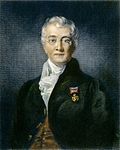Bell's phenomenon
Bell's phenomenon is a normal physiological response characterized by the upward and outward movement of the eye when it is closed or during an attempt to close it. This reflex is named after Sir Charles Bell, a Scottish surgeon and anatomist who first described it in the 19th century. Bell's phenomenon plays a crucial role in protecting the cornea by covering it with the upper eyelid, thus reducing the risk of damage when the eye is closed or during sleep.
Mechanism[edit]
The mechanism underlying Bell's phenomenon involves the coordination of several cranial nerves, primarily the oculomotor nerve (CN III) and the facial nerve (CN VII). When the facial nerve, which controls the muscles responsible for closing the eyelids (the orbicularis oculi), is activated, the oculomotor nerve simultaneously coordinates the upward and outward movement of the eyeball. This reflex action is believed to be a protective mechanism to shield the cornea and maintain the health of the eye's surface.
Clinical Significance[edit]
Bell's phenomenon has significant clinical implications, especially in conditions affecting the facial nerve, such as Bell's palsy. In Bell's palsy, the sudden weakness or paralysis of the facial nerve can lead to incomplete eyelid closure, exposing the cornea and increasing the risk of corneal damage. The presence of a strong Bell's phenomenon in such cases can provide some degree of corneal protection by ensuring that the eyeball is turned upwards when the eyelid attempts to close.
Additionally, Bell's phenomenon is considered during various ophthalmic surgeries and procedures. Surgeons assess the strength and direction of the phenomenon preoperatively as it can influence surgical outcomes, particularly in surgeries involving the eyelids or orbit.
Assessment[edit]
The assessment of Bell's phenomenon is a straightforward clinical examination. The examiner asks the patient to close their eyes gently and observes the movement of the eyeball. A normal response is characterized by the upward and outward rotation of the eyeball. The strength of the response can vary among individuals, and in some cases, it may be absent or minimal.
Variations and Abnormalities[edit]
While Bell's phenomenon is present in the majority of the population, there are variations in its expression. Some individuals may exhibit a very pronounced movement, while others may show only a slight upward rotation. In rare cases, individuals may have an inverse Bell's phenomenon, where the eyes move downwards rather than upwards. Abnormalities in Bell's phenomenon, such as its absence or reduced expression, can indicate neurological disorders or damage to the pathways involved in the reflex.
Conclusion[edit]
Bell's phenomenon is a protective reflex that plays a vital role in eye health. Understanding its mechanism and clinical significance is important for healthcare professionals, particularly those specializing in neurology and ophthalmology. Assessing Bell's phenomenon can provide valuable insights into the integrity of the cranial nerves involved and help in diagnosing and managing conditions that affect facial nerve function and eye health.
-
Bell's phenomenon
Ad. Transform your life with W8MD's Budget GLP-1 injections from $75


W8MD offers a medical weight loss program to lose weight in Philadelphia. Our physician-supervised medical weight loss provides:
- Weight loss injections in NYC (generic and brand names):
- Zepbound / Mounjaro, Wegovy / Ozempic, Saxenda
- Most insurances accepted or discounted self-pay rates. We will obtain insurance prior authorizations if needed.
- Generic GLP1 weight loss injections from $75 for the starting dose.
- Also offer prescription weight loss medications including Phentermine, Qsymia, Diethylpropion, Contrave etc.
NYC weight loss doctor appointmentsNYC weight loss doctor appointments
Start your NYC weight loss journey today at our NYC medical weight loss and Philadelphia medical weight loss clinics.
- Call 718-946-5500 to lose weight in NYC or for medical weight loss in Philadelphia 215-676-2334.
- Tags:NYC medical weight loss, Philadelphia lose weight Zepbound NYC, Budget GLP1 weight loss injections, Wegovy Philadelphia, Wegovy NYC, Philadelphia medical weight loss, Brookly weight loss and Wegovy NYC
|
WikiMD's Wellness Encyclopedia |
| Let Food Be Thy Medicine Medicine Thy Food - Hippocrates |
Medical Disclaimer: WikiMD is not a substitute for professional medical advice. The information on WikiMD is provided as an information resource only, may be incorrect, outdated or misleading, and is not to be used or relied on for any diagnostic or treatment purposes. Please consult your health care provider before making any healthcare decisions or for guidance about a specific medical condition. WikiMD expressly disclaims responsibility, and shall have no liability, for any damages, loss, injury, or liability whatsoever suffered as a result of your reliance on the information contained in this site. By visiting this site you agree to the foregoing terms and conditions, which may from time to time be changed or supplemented by WikiMD. If you do not agree to the foregoing terms and conditions, you should not enter or use this site. See full disclaimer.
Credits:Most images are courtesy of Wikimedia commons, and templates, categories Wikipedia, licensed under CC BY SA or similar.
Translate this page: - East Asian
中文,
日本,
한국어,
South Asian
हिन्दी,
தமிழ்,
తెలుగు,
Urdu,
ಕನ್ನಡ,
Southeast Asian
Indonesian,
Vietnamese,
Thai,
မြန်မာဘာသာ,
বাংলা
European
español,
Deutsch,
français,
Greek,
português do Brasil,
polski,
română,
русский,
Nederlands,
norsk,
svenska,
suomi,
Italian
Middle Eastern & African
عربى,
Turkish,
Persian,
Hebrew,
Afrikaans,
isiZulu,
Kiswahili,
Other
Bulgarian,
Hungarian,
Czech,
Swedish,
മലയാളം,
मराठी,
ਪੰਜਾਬੀ,
ગુજરાતી,
Portuguese,
Ukrainian
